Abstract
Traditionally, aversive control has been viewed as a separate domain within behavior theory. Sometimes this separateness has been based upon a distinction between reinforcement and punishment, and sometimes upon a distinction between positive and negative reinforcement. The latter is regarded here as the more compelling basis, due to some inherent procedural asymmetries. An approach to the interpretation of negative reinforcement is presented, with indication of types of experiments that support it and that also point to promising directions for further work. However, most of the interpretive issues that arise here are relevant to positively reinforced behavior as well. These include: possible reformulation of the operant/respondent distinction; the place of emotional concepts in behavior analysis; the need for simultaneous, complementary analysis on differing time scales; the understanding of behavioral situations with rewarding or aversive properties that depend as much upon the contingencies that the situations involve as upon the primary rewarding or aversive stimuli that they include. Thus, an adequate understanding of this domain, which has been traditionally viewed as distinct, has implications for all domains of behavior-analytic theory.
Keywords: negative reinforcement, punishment, emotion, aversive control, resonance, schedule-induced behavior, scales of analysis
Full text
PDF
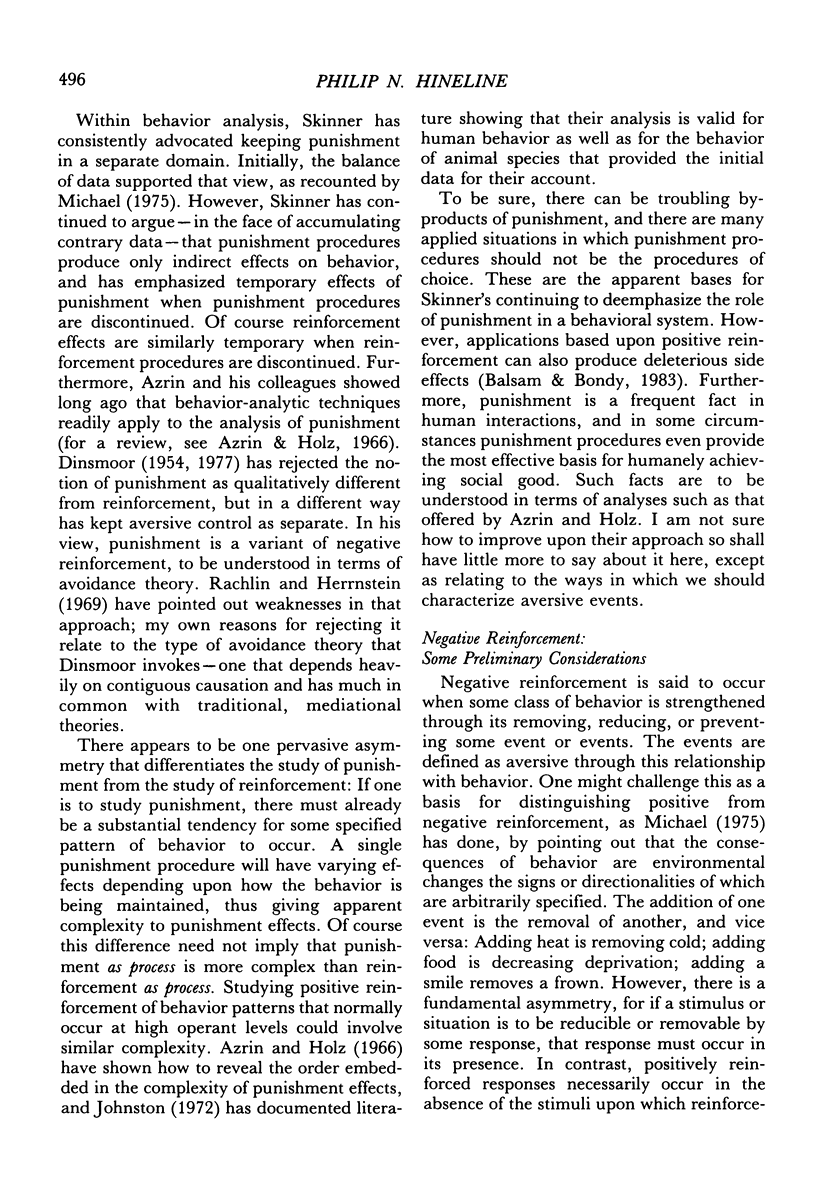
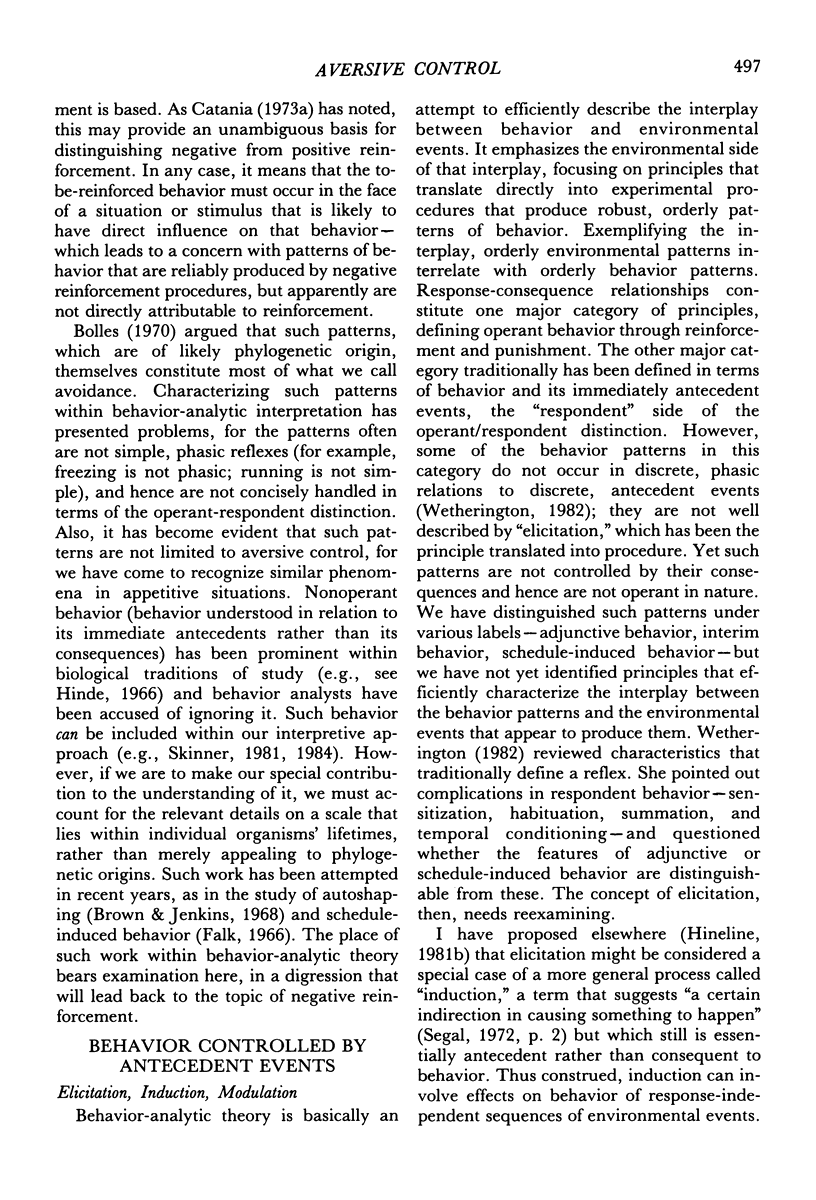



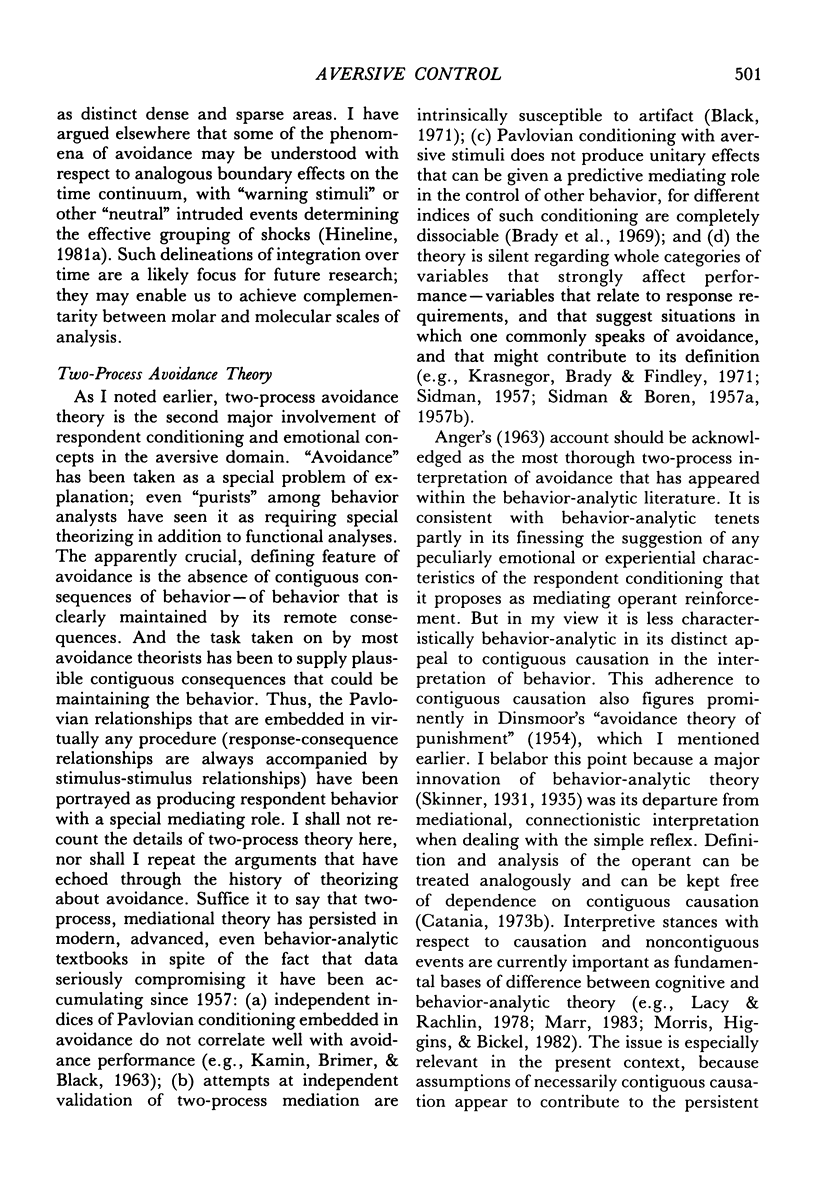

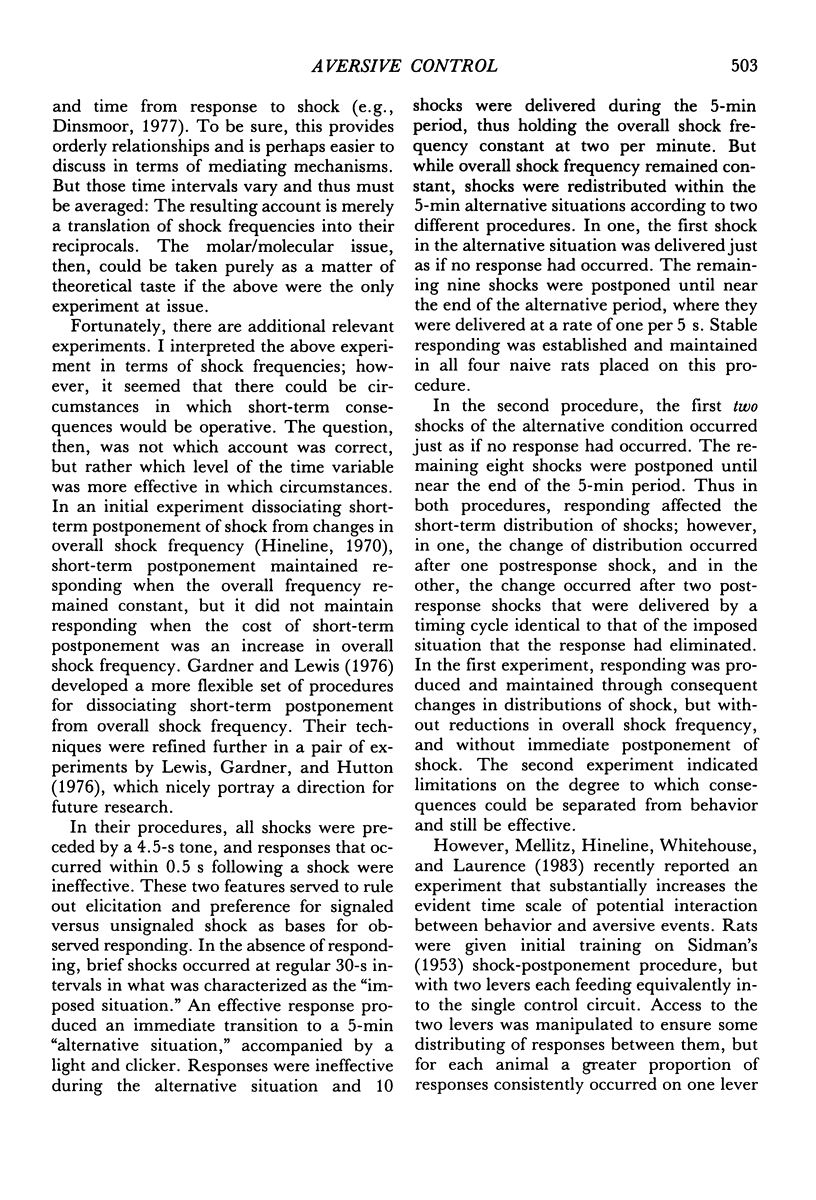
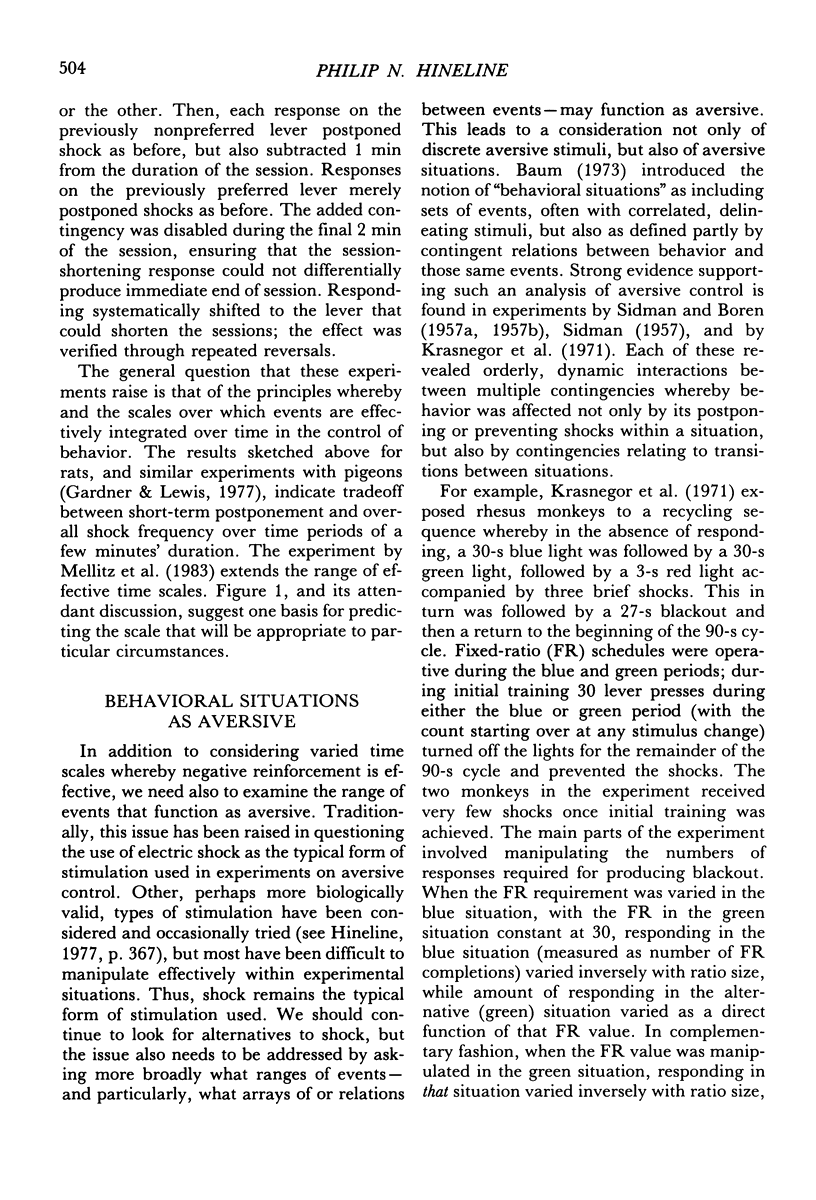

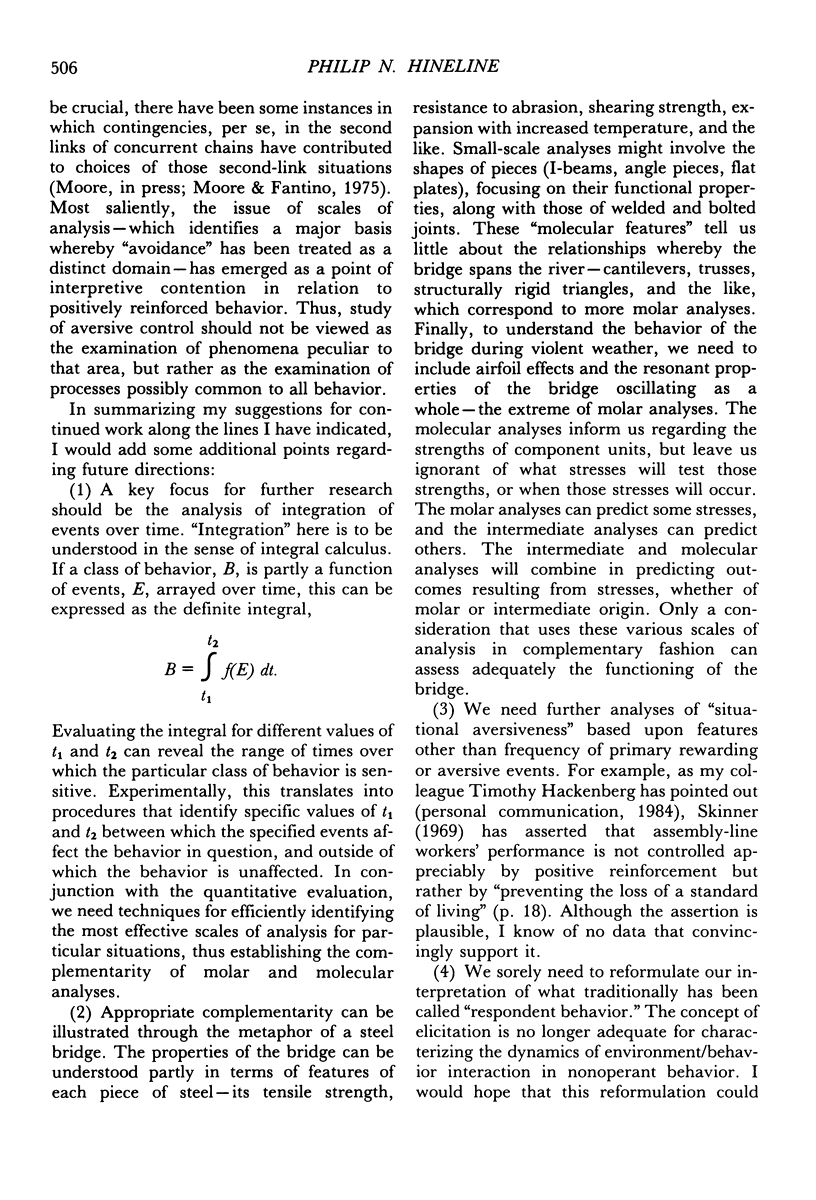
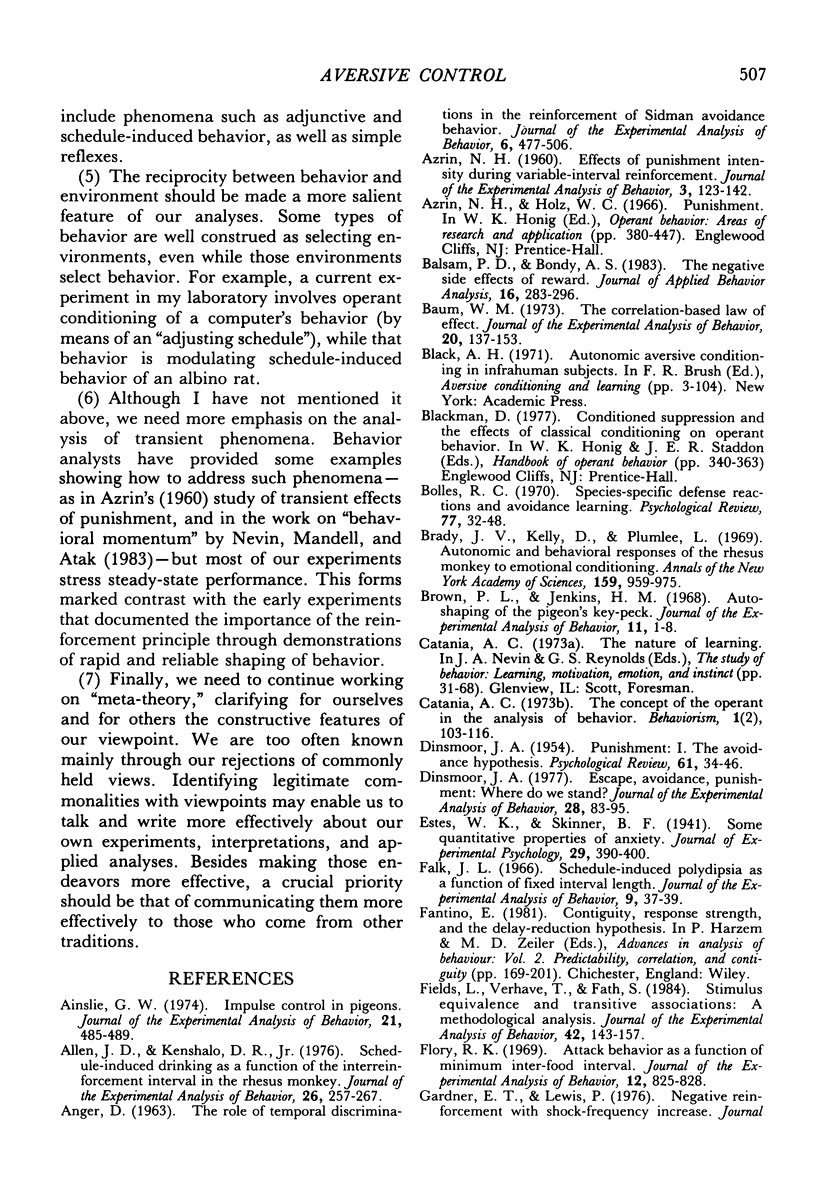
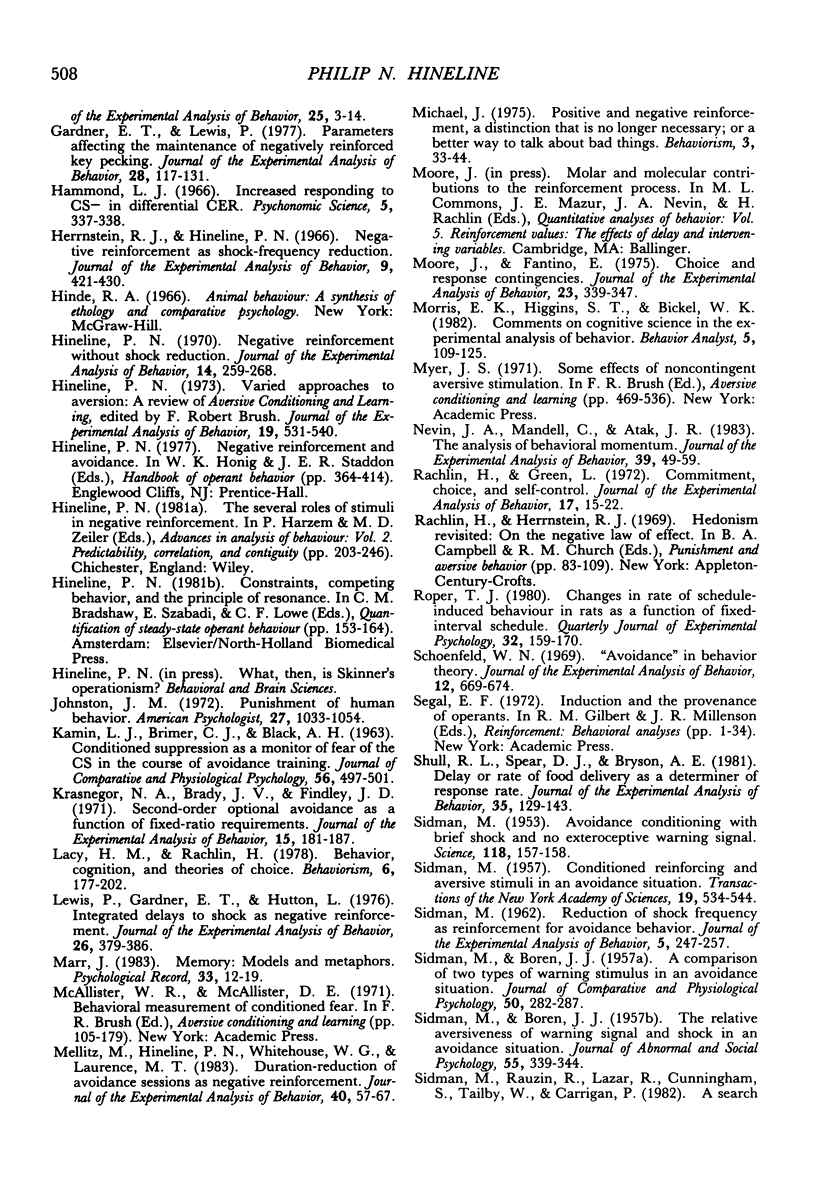

Selected References
These references are in PubMed. This may not be the complete list of references from this article.
- ANGER D. The role of temporal discriminations in the reinforcement of Sidman avoidance behavior. J Exp Anal Behav. 1963 Jul;6(3):477–506. doi: 10.1901/jeab.1963.6-s477. [DOI] [PMC free article] [PubMed] [Google Scholar]
- AZRIN N. H. Effects of punishment intensity during variable-interval reinforcement. J Exp Anal Behav. 1960 Apr;3:123–142. doi: 10.1901/jeab.1960.3-123. [DOI] [PMC free article] [PubMed] [Google Scholar]
- Ainslie G. W. Impulse control in pigeons. J Exp Anal Behav. 1974 May;21(3):485–489. doi: 10.1901/jeab.1974.21-485. [DOI] [PMC free article] [PubMed] [Google Scholar]
- Allen J. D., Kenshalo D. R. Schedule-induced drinking as a function of interreinforcement interval in the rhesus monkey. J Exp Anal Behav. 1976 Sep;26(2):257–267. doi: 10.1901/jeab.1976.26-257. [DOI] [PMC free article] [PubMed] [Google Scholar]
- Balsam P. D., Bondy A. S. The negative side effects of reward. J Appl Behav Anal. 1983 Fall;16(3):283–296. doi: 10.1901/jaba.1983.16-283. [DOI] [PMC free article] [PubMed] [Google Scholar]
- Baum W. M. The correlation-based law of effect. J Exp Anal Behav. 1973 Jul;20(1):137–153. doi: 10.1901/jeab.1973.20-137. [DOI] [PMC free article] [PubMed] [Google Scholar]
- Brady J. V., Kelly D., Plumlee L. Autonomic and behavioral responses of the rhesus monkey to emotional conditioning. Ann N Y Acad Sci. 1969 Jul 30;159(3):959–975. doi: 10.1111/j.1749-6632.1969.tb12991.x. [DOI] [PubMed] [Google Scholar]
- Brown P. L., Jenkins H. M. Auto-shaping of the pigeon's key-peck. J Exp Anal Behav. 1968 Jan;11(1):1–8. doi: 10.1901/jeab.1968.11-1. [DOI] [PMC free article] [PubMed] [Google Scholar]
- DINSMOOR J. A. Punishment. I. The avoidance hypothesis. Psychol Rev. 1954 Jan;61(1):34–46. doi: 10.1037/h0062725. [DOI] [PubMed] [Google Scholar]
- Dinsmoor J. A. Escape, avoidance, punishment: where do we stand? J Exp Anal Behav. 1977 Jul;28(1):83–95. doi: 10.1901/jeab.1977.28-83. [DOI] [PMC free article] [PubMed] [Google Scholar]
- Falk J. L. Schedule-induced polydipsia as a function of fixed interval length. J Exp Anal Behav. 1966 Jan;9(1):37–39. doi: 10.1901/jeab.1966.9-37. [DOI] [PMC free article] [PubMed] [Google Scholar]
- Fields L., Verhave T., Fath S. Stimulus equivalence and transitive associations: A methodological analysis. J Exp Anal Behav. 1984 Jul;42(1):143–157. doi: 10.1901/jeab.1984.42-143. [DOI] [PMC free article] [PubMed] [Google Scholar]
- Flory R. Attack behavior as a function of minimum inter-food interval. J Exp Anal Behav. 1969 Sep;12(5):825–828. doi: 10.1901/jeab.1969.12-825. [DOI] [PMC free article] [PubMed] [Google Scholar]
- Gardner E. T., Lewis P. Negative reinforcement with shock-frequency increase. J Exp Anal Behav. 1976 Jan;25(1):3–14. doi: 10.1901/jeab.1976.25-3. [DOI] [PMC free article] [PubMed] [Google Scholar]
- Gardner E. T., Lewis P. Parameters affecting the maintenance of negatively reinforced key pecking. J Exp Anal Behav. 1977 Sep;28(2):117–131. doi: 10.1901/jeab.1977.28-117. [DOI] [PMC free article] [PubMed] [Google Scholar]
- Herrnstein R. J., Hineline P. N. Negative reinforcement as shock-frequency reduction. J Exp Anal Behav. 1966 Jul;9(4):421–430. doi: 10.1901/jeab.1966.9-421. [DOI] [PMC free article] [PubMed] [Google Scholar]
- Hineline P. N. Negative reinforcement without shock reduction. J Exp Anal Behav. 1970 Nov;14(3):259–268. doi: 10.1901/jeab.1970.14-259. [DOI] [PMC free article] [PubMed] [Google Scholar]
- Johnston J. M. Punishment of human behavior. Am Psychol. 1972 Nov;27(11):1033–1054. doi: 10.1037/h0033887. [DOI] [PubMed] [Google Scholar]
- Krasnegor N. A., Brady J. V., Findley J. D. Second-order optional avoidance as a function of fixed-ratio requirements. J Exp Anal Behav. 1971 Mar;15(2):181–187. doi: 10.1901/jeab.1971.15-181. [DOI] [PMC free article] [PubMed] [Google Scholar]
- Lewis P., Gardner E. T., Hutton L. Integrated delays to shock as negative reinforcement. J Exp Anal Behav. 1976 Nov;26(3):379–386. doi: 10.1901/jeab.1976.26-379. [DOI] [PMC free article] [PubMed] [Google Scholar]
- Mellitz M., Hineline P. N., Whitehouse W. G., Laurence M. T. Duration-reduction of avoidance sessions as negative reinforcement. J Exp Anal Behav. 1983 Jul;40(1):57–67. doi: 10.1901/jeab.1983.40-57. [DOI] [PMC free article] [PubMed] [Google Scholar]
- Moore J., Fantino E. Choice and response contingencies. J Exp Anal Behav. 1975 May;23(3):339–347. doi: 10.1901/jeab.1975.23-339. [DOI] [PMC free article] [PubMed] [Google Scholar]
- Nevin J. A., Mandell C., Atak J. R. The analysis of behavioral momentum. J Exp Anal Behav. 1983 Jan;39(1):49–59. doi: 10.1901/jeab.1983.39-49. [DOI] [PMC free article] [PubMed] [Google Scholar]
- doi: 10.1901/jeab.1973.19-531. [DOI] [PMC free article] [Google Scholar]
- Rachlin H., Green L. Commitment, choice and self-control. J Exp Anal Behav. 1972 Jan;17(1):15–22. doi: 10.1901/jeab.1972.17-15. [DOI] [PMC free article] [PubMed] [Google Scholar]
- SIDMAN M. Avoidance conditioning with brief shock and no exteroceptive warning signal. Science. 1953 Aug 7;118(3058):157–158. doi: 10.1126/science.118.3058.157. [DOI] [PubMed] [Google Scholar]
- SIDMAN M., BOREN J. J. A comparison of two types of warning stimulus in an avoidance situation. J Comp Physiol Psychol. 1957 Jun;50(3):282–287. doi: 10.1037/h0046474. [DOI] [PubMed] [Google Scholar]
- SIDMAN M., BOREN J. J. The relative aversiveness of warning signal and shock in an avoidance situation. J Abnorm Psychol. 1957 Nov;55(3):339–344. doi: 10.1037/h0043237. [DOI] [PubMed] [Google Scholar]
- SIDMAN M. Conditioned reinforcing and aversive stimuli in an avoidance situation. Trans N Y Acad Sci. 1957 Apr;19(6):534–544. doi: 10.1111/j.2164-0947.1957.tb00547.x. [DOI] [PubMed] [Google Scholar]
- SIDMAN M. Reduction of shock frequency as reinforcement for avoidance behavior. J Exp Anal Behav. 1962 Apr;5:247–257. doi: 10.1901/jeab.1962.5-247. [DOI] [PMC free article] [PubMed] [Google Scholar]
- Schoenfeld W. N. "Avoidance" in behavior theory. J Exp Anal Behav. 1969 Jul;12(4):669–674. doi: 10.1901/jeab.1969.12-669. [DOI] [PMC free article] [PubMed] [Google Scholar]
- Shull R. L., Spear D. J., Bryson A. E. Delay or rate of food delivery as determiners of response rate. J Exp Anal Behav. 1981 Mar;35(2):129–143. doi: 10.1901/jeab.1981.35-129. [DOI] [PMC free article] [PubMed] [Google Scholar]
- Sidman M., Rauzin R., Lazar R., Cunningham S., Tailby W., Carrigan P. A search for symmetry in the conditional discriminations of rhesus monkeys, baboons, and children. J Exp Anal Behav. 1982 Jan;37(1):23–44. doi: 10.1901/jeab.1982.37-23. [DOI] [PMC free article] [PubMed] [Google Scholar]
- Sidman M., Tailby W. Conditional discrimination vs. matching to sample: an expansion of the testing paradigm. J Exp Anal Behav. 1982 Jan;37(1):5–22. doi: 10.1901/jeab.1982.37-5. [DOI] [PMC free article] [PubMed] [Google Scholar]
- Skinner B. F. Selection by consequences. Science. 1981 Jul 31;213(4507):501–504. doi: 10.1126/science.7244649. [DOI] [PubMed] [Google Scholar]
- Skinner B. F. The evolution of behavior. J Exp Anal Behav. 1984 Mar;41(2):217–221. doi: 10.1901/jeab.1984.41-217. [DOI] [PMC free article] [PubMed] [Google Scholar]
- Wetherington C. L. Is adjunctive behavior a third class of behavior? Neurosci Biobehav Rev. 1982 Fall;6(3):329–350. doi: 10.1016/0149-7634(82)90045-8. [DOI] [PubMed] [Google Scholar]


